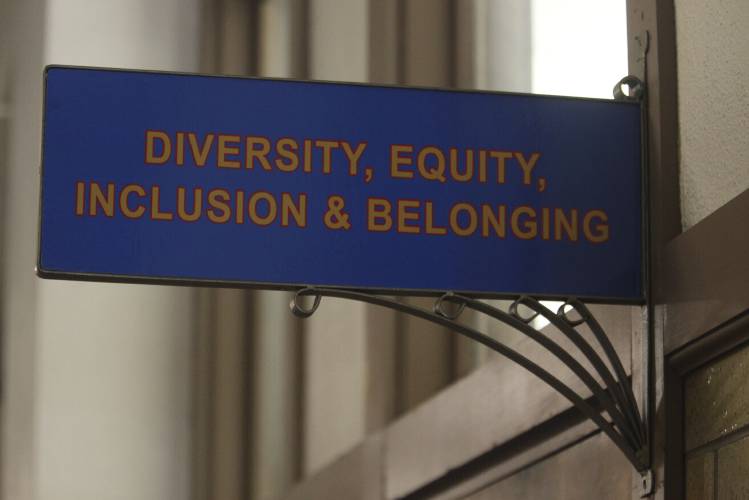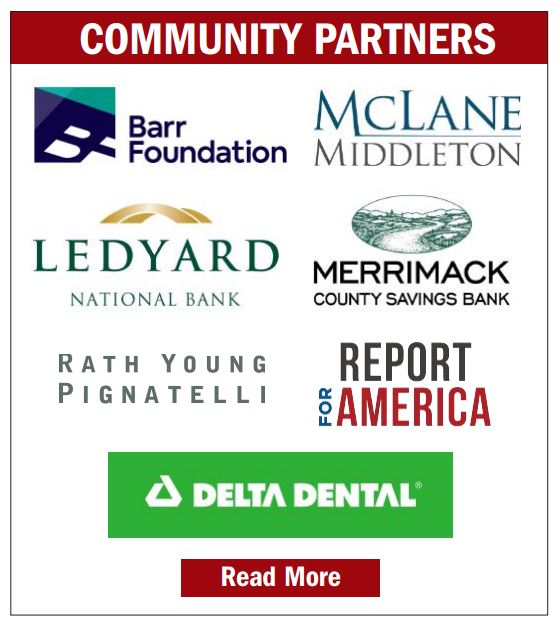Opinion: Education in a pluralistic setting

FILE - The sign above the door to the Office of Diversity, Equity, Inclusion and Belonging inside the main administration building on the main University of Kansas campus is seen on Friday, April 12, 2024, in Lawrence, Kan. (AP Photo/John Hanna, File) John Hanna
| Published: 05-04-2025 2:00 PM |
John Buttrick writes from his Vermont Folk Rocker in his Concord home, Minds Crossing. He can be reached at johndbuttrick@gmail.com.
The Center on Education Policy at the George Washington University, a national independent source for research and information about public education, wrote in 2020, “The Founding Fathers maintained that the success of the fragile American democracy would depend on the competency of its citizens.”
Their summary, contained in a report on the history and evolution of American public education, continued: “They believed strongly that preserving democracy would require an educated population that could understand political and social issues and would participate in civic life, vote wisely, protect their rights and freedoms and resist tyrants and demagogues. Character and virtue were also considered essential to good citizenship, and education was seen as a means to provide moral instruction and build character.”
Then, in the 1830s, Horace Mann, a Massachusetts legislator and secretary of that state’s board of education, began to advocate for the creation of public schools that would be universally available to all children, free of charge and funded by the state. Character building and values instruction remained important pillars of education for more than 150 years.
However, teaching the marks of good character, good citizenship and good moral choices have come under suspicion and have been disappearing from the curriculum. With no agreed-upon universal values, many people are turning to their own personal needs and well-being to define their value system. They are forming individual self-centered self-defined values to evaluate beliefs and conduct.
Therefore, many parents of a K-12 school child expect their own values to be taught in the classroom and brought to bear on such issues as prayer and topics of religion, racial bias, sex education courses, anti-Semitism and LGBT+. The problem is, when relativism is in play, there are as many different values as there are parents.
Two movements have grown out of this weakening of trust in the existence of universal values: Make America Great Again and Diversity, Equity and Inclusion. MAGA reaches back to those outdated norms and values, such as the belief that God created white men as superior over women and people of color. Also, today’s multiple conflicting values and standards for morality, call for a winner and losers. Trump claims his point of view to be that of the non-negotiable winner.
However, to enforce a set-in-stone viewpoint in schools requires indoctrination. The Trump administration is seeking to transform education into teaching only Trump’s “winning” viewpoint and insisting it be the universal value for all people.
Article continues after...
Yesterday's Most Read Articles
 With Steeplegate still held up in court, city privately debates public investment
With Steeplegate still held up in court, city privately debates public investment
 Sudden pile of trash near Exit 13 on Manchester Street in Concord considered ‘illegal dumping’
Sudden pile of trash near Exit 13 on Manchester Street in Concord considered ‘illegal dumping’
 Mullet madness: Young man who died in motorcycle accident remembered at local fundraiser
Mullet madness: Young man who died in motorcycle accident remembered at local fundraiser
 OSHA investigates Pittsfield partial building collapse
OSHA investigates Pittsfield partial building collapse
 ‘Peace of mind’: As New Hampshire nixes car inspections, some Concord residents still plan to get them
‘Peace of mind’: As New Hampshire nixes car inspections, some Concord residents still plan to get them
In contrast, the DEI movement is a communal attempt to spell out an agreed-upon moral guideline. Diversity, equity and inclusion recognize that different people can come together in a community to develop a morality suited to the well-being of everyone. However, some people have the perception that diversity means dividing, judging students instead of bringing them together.
To clarify the original intent of “diversity”, the Pluralism Project at Harvard University has proposed adopting the concept of “pluralism.” It more clearly communicates “an active engagement with different cultures and identities in sites where open dialogue is possible,” according to a blog post on the project’s website.
Pluralism can be understood as an expression of democracy, where children from diverse backgrounds interact in the same classrooms, find common ground, learn to respect each other and learn skills of getting along and making decisions. I learned from one of my daughters about a school in Tucson, Arizona, where pre-K children were successfully taught these skills. Recognizing the reality that the students in a classroom are from pluralistic backgrounds, invited discussions of multiple options and beliefs that led them to cooperative relationships, fresh insights, and new possibilities. Educators found the freedom to teach acceptance of others and equity for all.
The news reports that New Hampshire schools are caught in the controversy of DEI presence in the classrooms. It is feared that DEI will divide, label and threaten some students. However, if that fear dominates, children will miss the opportunity for an education envisioned by our Founders.
It is evident that pluralism was foreshadowed in the Founders’ description of an educated population that could understand political and social issues and would participate in civic life, vote wisely, protect the population’s rights and freedoms and resist tyrants and demagogues. Their understanding of values and morality, character and virtue may have lost its influence.
But the new concept of pluralism may free educators and students to safely seek an agreed-upon value system and morality for good citizenship. Fear not! Competent citizens can strengthen a fragile democracy.







 Opinion: Trumpism in a dying democracy
Opinion: Trumpism in a dying democracy Opinion: What Coolidge’s century-old decision can teach us today
Opinion: What Coolidge’s century-old decision can teach us today Opinion: The art of diplomacy
Opinion: The art of diplomacy Opinion: After Roe: Three years of resistance, care and community
Opinion: After Roe: Three years of resistance, care and community
